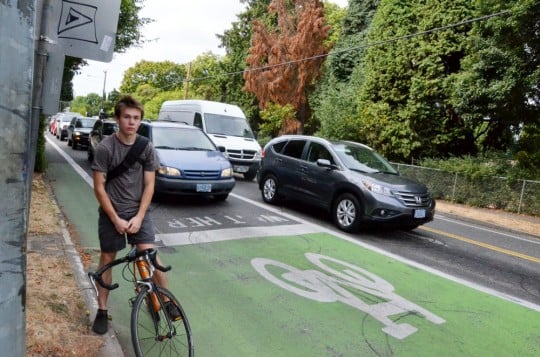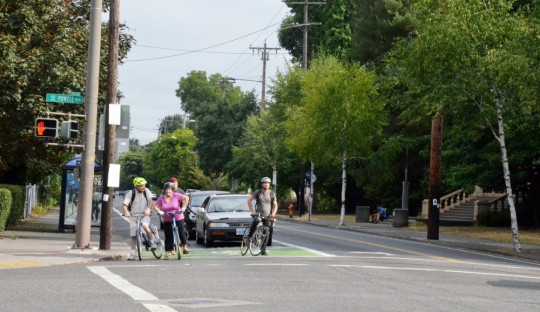
(Photos: M.Andersen/BikePortland)
Three weeks after being asked if it can cite any evidence supporting its claim that removing a bike lane can sometimes increase bike safety, the State of Oregon has come up empty.
Moreover, a state spokeswoman wrote in an email Tuesday that four studies cited by the City of Portland that document safety benefits of bike lanes are inadequate, though the state did not say in what way the studies fall short.
“More research needs to be done,” the Oregon Department of Transportation said in its statement.
Research notwithstanding, the Oregon Department of Transportation is continuing to deny the City of Portland’s request to install a new stoplight at 28th Avenue and Powell (which would let the city create a new north-south neighborhood greenway on 28th) unless the city agrees to first remove the narrow bike lanes from nearby 26th Avenue.
Those bike lanes, which cross Powell directly in front of Cleveland High School and connect to the major commercial node at 26th and Clinton, are currently used for about 600 to 800 cycling trips a day.
ODOT’s statement came one week after BikePortland asked if the state had any response to a letter about 26th Avenue, sent by Portland Bicycle Planning Coordinator Roger Geller to the city’s bicycle advisory committee. In the letter, Geller had cited four studies showing, he said, that even a very narrow bike lane like the one on 26th Avenue tends to increase safety on the street.
“Research on this topic is not always conclusive and can even be conflicting. More research needs to be done.”
— Oregon Department of Transportation, on whether narrow bike lanes are safer than no bike lanes
According to the studies, even narrow bike lanes prompt people to bike further from the doors of parked cars and prompt people to give bike users more space when passing them in a car. According to a federally funded academic meta-analysis, bike lanes reduce crash rates on a street by 36 to 50 percent.
In an email Tuesday, ODOT said the idea that bad bike lanes are better than nothing was not a reasonable conclusion to draw from those studies, but didn’t say why Geller’s interpretation was inaccurate.
Also in that email, the state denied that the head of its engineering department had ever claimed, in an interview about the 26th Avenue bike lane, that there are “conflicting studies” about the phenomenon of “safety in numbers,” the frequently cited observation that increasing the number of bikes on a street or in a city tends to reduce the risk of biking.
Narrow bike lanes are better than nothing, city says
Aside from the question of evidence, the state’s fundamental argument is fairly simple: if you remove the 3.5-foot bike lanes from 26th Avenue and create a greenway crossing at 28th, most people will probably cross at 28th, which is safer than 26th because it will have fewer turning vehicles.
But if you do that without removing the bike lane from 26th, the state says, many people will keep biking on 26th.
The city, on the other hand, argues that people should be able to choose which street to bike on, and that many people are likely to bike on 26th Avenue (or at least to cross Powell there) whether or not there is a bike lane. Removing the bike lane, the city says, will make 26th Avenue more dangerous for no good reason.
Advertisement
Here are the four studies Geller cited, showing (he said) that even narrow, substandard bike lanes like the ones on 26th Avenue are safer than a street with no bike lanes:
“Evaluation of Shared-Use Facilities for Bicycles and Motor Vehicles,” Transportation Research Board, Record No. 1578, Harkey, D.L, Stewart, J.R., 1997 concluded that “bicycle lanes as narrow as 0.92 m (3 ft) provide sufficient space for motorists and bicyclists to interact safely. At the same time, a 1.22m (4-ft) wide bicycle lane tended to optimize operating conditions because there were very few differences in the measures of effectiveness when 1.22-m lanes were compared with wider lanes.”
“Effect of Wide Curb Lane Conversions on Bicycle and Motor Vehicle Interactions,” Report prepared for the Florida Department of Transportation, William W. Hunter, John R. Feaganes, Highway Safety Research Center, University of North Carolina, April 2004; concluded that people bicycling and people driving positioned themselves more safely on a roadway with 11’ travel lanes and 3’ bicycle lanes than with just a 14’ travel lane.
National Cooperative Highway Research Program Report 766 “Recommended Bicycle Lane Widths for Various Roadway Characteristics,” Transportation Research Board, 2014 provides a literature review that states the following:
“Bike lanes have a positive impact on safety when compared with unmarked roadways. Bahar et al. (2008) found that the presence of a bike lane reduces bicycle crashes by 36%. This finding is supported by other research.”
“Reynolds et al. (2009) examined the relationship between bicycle infrastructure and cyclist safety through a review of 23 papers from 1975 through 2009. When examining the studies related to roadway segments (rather than intersections), marked bike lanes and bike routes were found to reduce crash rates and injuries by about half when compared to unmodified roadways. The safety effectiveness of specific bicycle facility designs was not described by Reynolds et al.”“How Pavement Markings Influence Bicycle and Motor Vehicle Positioning: A Case Study in Cambridge, MA” Report prepared for City of Cambridge, MA, Ron Van Houten, Mount Saint Vincent University and Cara Seiderman, City of Cambridge, concluded bicycle lanes “encouraged cyclists to ride farther away from parked cars” helping to reduce the chances of being doored when compared to streets without bicycle lanes.
In an email Tuesday, ODOT spokeswoman Kimberly Dinwiddie offered “ODOT’s response” to Geller’s citation of these studies. Here it is, in its entirety: “We don’t feel it’s fair to boil down many research studies into one black-and-white summary statement. It’s not that simple. Research on this topic is not always conclusive and can even be conflicting. More research needs to be done.”
State says engineering manager never claimed that reducing bike traffic can improve safety
Another issue raised by BikePortland’s Aug. 5 interview with several ODOT officials, including regional traffic engineering manager Sue D’Agnese, was what D’Agnese had meant when she said that there are “conflicting studies” about whether having more bikes at a location increases bike safety.
Because she said ODOT was motivated “only by safety” in pushing the city to remove the 26th Avenue bike lane, I’d asked her whether she had any evidence that removing the 26th Avenue bike lane would in fact improve safety. Even if most people began crossing at 28th, I said, the people still biking on 26th would see increased risk — if nothing else because there would be so few of them.
In the interview, D’Agnese responded that the “safety in numbers” trend was not always true.
“There’s conflicting studies in the transportation safety realm,” she said. “There’s also studies that when bike volumes are high, crash rate goes up. … It depends on the geometry and the site-specific conditions.”
At the time, I told D’Agnese that this was contrary to everything I’d heard about the subject as a reporter, so I would like to know where that information was coming from. On Aug. 18 I sent another email making the request more explicit.
In her email Tuesday, Dinwiddie (who wasn’t herself present at the first interview) wrote that ODOT believes my notes from the interview were inaccurate:
Unfortunately that’s not an accurate summary of what Sue said. She said: “Regardless of mode, generally more traffic results in a higher frequency (total number) of crashes due to the higher exposure. Therefore, an increase in bike traffic could result in an increase in the frequency of crashes. However, an increase in the frequency of bike crashes could occur at the same time there is an overall lower crash rate due to higher total traffic volumes.”
That’s a perfectly reasonable statement — to carry it to an extreme, of course there would be zero bike crashes if no one ever rode bikes — but it doesn’t have any bearing on how the state is balancing the potentially increased risk of biking on 26th Avenue against the safety benefits of a new signal at 28th. Also, it’s definitely not anything close to what D’Agnese said.
Assuming ODOT does not change course, the city’s staffers have not yet reached a decision about whether to scrap their request for a signal on 28th Avenue or to scrap the bike lane on 26th.
“Our intent is to keep our options open,” city project manager Rich Newlands wrote Tuesday. “We believe there are still creative solutions that will allow us to have both the new signal at 28th and retain the bike lanes on 26th.”



